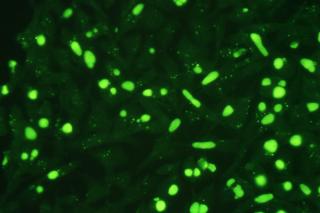Latest Briefing in Sustainability and Communities for 2012

Ovine chlamydiosis - the most common infectious cause of prenatal lamb death in the UK
Ovine Enzootic Abortion (OEA) (also known as Enzootic Abortion of Ewes (EAE) or ovine chlamydiosis) is caused by the bacterium Chlamydia abortus (formerly known as Chlamydophila abortus) and is one of the major infectious causes of abortion in sheep and goats worldwide, and the most common cause in the UK. The disease is considered to be ‘endemic’ in the UK as it is constantly present in the livestock population, but also ‘enzootic’ as it only affects a limited number of animals at any one time. The disease is a major health and welfare issue for the livestock industry with large economic implications amounting to tens of millions of pounds annually. Chlamydia abortus can also infect cattle, pigs and horses but disease outbreaks are much more sporadic and less frequent. Infection can also be passed from animal to human (zoonotic) in whom it can cause spontaneous abortion (miscarriage). It can also be potentially life-threatening for pregnant women, although reported cases of transmission are rare.
It is difficult to identify infection in individual animals within a flock, making the disease difficult to control. The first sign of infection is often the appearance of dead or live weak lambs in the last few weeks of pregnancy with visibly diseased placentas and a vaginal discharge of infective fluid, which can last for several days. The infected placentas, coats of dead lambs, contaminated bedding and vaginal discharges are the major sources of infection for other animals. In an extended lambing season uninfected ewes can pick up infection from another ewe and abort in the same lambing season. There is little evidence that the disease can be transmitted mechanically by rams.
The spread of disease is difficult to control as infection of a non-pregnant ewe only becomes apparent during pregnancy and it is currently impossible to identify infection in such animals through diagnostic testing. For this reason care must be taken when sourcing and introducing replacement stock. The introduction of only a few infected animals may be sufficient to lead to an abortion storm affecting up to 30% of ewes within two years. Once an animal has aborted it is considered immune to further disease, although it can still infect other animals. Although antibiotics can be used to reduce losses at the first signs of a problem they do not eradicate the disease. Thus, currently the most effective means of controlling infection is through the use of vaccination.
Read morePublished on 22 October 2012 in Sustainability and Communities , Food, health and wellbeing
Briefings in Sustainability and Communities for 2012
Parachlamydia - an emerging potential cause of abortion in cattle in the UK
Reproductive failure in cattle is a major concern to livestock producers worldwide. An emerging group of bacteria known as Chlamydia-like organisms have been associated with cases of bovine abortion, as well as with human respiratory and reproductive infections. Read more
Published on 9 October 2012 in Sustainability and Communities , Food, health and wellbeing
Sustainability-oriented innovation for competitive advantage: Does the business environment matter?
Sustainability-oriented innovation within firms, such as the development of eco-friendly production methods, is seen as a route for product differentiation, value creation and as a way for firms to enhance their bargaining power within the supply chain. Read more
Published on 11 September 2012 in Sustainability and Communities , Ecosystems and biodiversity
Long-Term Land Use Change on the Machair and its Impact on Biodiversity
Machair is a distinctive type of coastal grassland restricted to about 25,000 ha in world-wide extent; 17,500 ha of this resource are in Scotland. Read more
Published on 3 May 2012 in Sustainability and Communities , Ecosystems and biodiversity
Bracken and the Asulam ban
Bracken is well known as an agricultural, ecological and health problem with little in the way of redeeming features. Read more
Published on 2 May 2012 in Sustainability and Communities , Ecosystems and biodiversity
KE of science - changing behaviours that challenge society
Society today faces a number of challenges, such as climate change, that require individuals to collectively change their behaviour in ways that incur additional costs (financial and/or non-financial). Read more
Published on 25 April 2012 in Sustainability and Communities
Sustainable Intensification within Scotland
This brief outlines the results of a recently published discussion document on applying the concept of Sustainable Intensification to Scotland. Read more
Published on 20 March 2012 in Sustainability and Communities
Marine litter issues, impacts and action-contributing to a marine litter strategy for Scotland
Increasingly, policy makers and the public are experiencing the problem of litter in our seas and on our beaches. Read more
Published on 2 February 2012 in Sustainability and Communities , Climate, water and energy , Ecosystems and biodiversity







